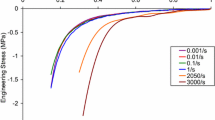Abstract
A phenomenological study of the process occurring when a plane shock wave reflected off an aqueous foam column filling the test section of a vertical shock tube has been undertaken. The experiments were conducted with initial shock wave Mach numbers in the range \(1.25\le {M}_\mathrm{s} \le 1.7\) and foam column heights in the range 100–450 mm. Miniature piezotrone circuit electronic pressure transducers were used to record the pressure histories upstream and alongside the foam column. The aim of these experiments was to find a simple way to eliminate a spatial averaging as an artifact of the pressure history recorded by the side-on transducer. For this purpose, we discuss first the common behaviors of the pressure traces in extended time scales. These observations evidently quantify the low frequency variations of the pressure field within the different flow domains of the shock tube. Thereafter, we focus on the fronts of the pressure signals, which, in turn, characterize the high-frequency response of the foam column to the shock wave impact. Since the front shape and the amplitude of the pressure signal most likely play a significant role in the foam destruction, phase changes and/or other physical factors, such as high capacity, viscosity, etc., the common practice of the data processing is revised and discussed in detail. Generally, side-on pressure measurements must be used with great caution when performed in wet aqueous foams, because the low sound speed is especially prone to this effect. Since the spatial averaged recorded pressure signals do not reproduce well the real behaviors of the pressure rise, the recorded shape of the shock wave front in the foam appears much thicker. It is also found that when a thin liquid film wet the sensing membrane, the transducer sensitivity was changed. As a result, the pressure recorded in the foam could exceed the real amplitude of the post-shock wave flow. A simple procedure, which allows correcting this imperfection, is discussed in detail.















Similar content being viewed by others
References
Weaire, D., Cox, S., Brake, K.: Chapter in cellular ceramics. In: Colombo, P., Scheffler, M. (eds.) Liquid Foams. Wiley-VCH, Weinheim (2005)
Denkov, N.D., Tcholakova, S., Golemanov, K., Subramanian, V., Lips, A.: Foam-wall friction: effect of air volume fraction for tangentially immobile bubble surface. Colloids Surf. A Physicochem. Eng. Aspects 282–283, 329–347 (2006)
Denkov, N.D., Subramanian, V., Gurovich, D., Lips, A.: Wall slip and viscous dissipation in sheared foams: effect of surface mobility. Colloids Surf. A Physicochem. Eng. Aspects 263, 129–145 (2005)
Briceno, M.I., Joseph, D.D.: Self-lubricated transport of aqueous foams in horizontal conduits. Int. J. Multiphase Flow 29, 1817–1831 (2003)
Britan, A., Shapiro, H., Ben-Dor, G.: Foams for blast mitigation, In: Foam Engineering: Fundamentals and Applications, Chap. 19, pp. 477–512 (2012)
Rahman, S., Timofeev, E., Kleine, H.: Pressure measurements in laboratory-scale blast wave flow fields. Rev. Sci. Instr. 78, 125106-1–125106-11 (2007)
Vakhnenko, V., Kudinov, V., Palamarchuk, B.: Damping of strong shocks in relaxing media. Comb. Expl. Shock Waves 20(1), 97–103 (1984)
Britan, A., Ben-Dor, G., Shapiro, H., Liverts, M., Shreiber, I.: Drainage effects on shock wave propagating through aqueous foams. Colloids Surf. A Physicochem. Eng. Aspects 309, 137–150 (2007)
Britan, A., Shapiro, H., Ben-Dor, G.: The contribution of shock tubes to simplified analysis of gas filtration through granular media. J. Fluid Mech. 586, 147–176 (2007)
Britan, A., Liverts, M., Ben-Dor, G.: Shock wave propagation through wet particulate foam. Colloids Surf. A Physicochem. Eng. Aspects 382, 145–153 (2011)
Skews, B.W., Atkins, M.D., Seitz, M.W.: Gas dynamic and physical behavior of compressible porous foams struck by a weak shock wave. In: Takayama, K. (eds.) Proceedings of the \(18{\rm th}\) International Symposium on Shock Waves, pp. 511–517 (1991)
de Krasinski, J.S.: Some aspects of the fluid dynamics of liquid–air foams of high dryness fraction. Prog. Aero. Sci. 29, 125–163 (1992)
Batchelor, G.K.: An Introduction to Fluid Dynamics. Cambridge University Press, Cambridge (1968)
Van Wijngaarden, L.: One dimensional flow of liquids containing small gas bubbles. Ann. Rev. Fluid Mech. 4, 369–396 (1972)
Goldfarb, I., Orenbach, Z., Shreiber, I., Vafina, F.: Sound and weak shock wave propagation in gas–liquid foams. Shock Waves 7, 77–88 (1997)
Khosla, A.A.: Study of shock wave attenuation. Ph.D. Thesis, University of Calgary (1974)
Reinelt, D.A., Kraynik, A.M.: On the shearing flow of foams and concentrated emulsions. J. Fluid Mech. 215, 431–455 (1990)
Heller, J.P., Kuntamukkula, M.S.: Critical review of the foam rheology literature. Ind. Eng. Chem. Res. 26, 318–325 (1987)
Gopal, A.D., Durian, D.J.: Relaxing in foam. Phys. Rev. Lett. 91, 188–303 (2003)
Khan, S.A., Armstrong, R.C.: Rheology of foams: I. Theory for dry foams. J. Non-Newton Fluid Mech. 22, 1–22 (1986)
Gajbhiye, R.N., Kam, S.I.: Characterization of foam flow in horizontal pipes by using two-flow-regime concept. Chem. Eng. Sci. 66, 1536–1549 (2011)
Calvert, J.R., Nezhati, K.: A rheological model for a liquid–gas foam. Int. J. Heat Fluid Flow 7, 164–168 (1986)
Calvert, J.R.: Pressure drop for foam flow through pipes. Int. J. Heat Fluid Flow 11, 236–241 (1990)
Blondin, E., Doubliez, L.: Particle imaging velocimetry of a wet aqueous foam with an underlying liquid film. Exp. Fluids 32, 294–301 (2002)
Tisne, P., Aloui, F., Doubliez, L.: Analysis of wall shear stress in wet foam flows using the electrochemical method. Int. J. Multiphase Flow 29, 841–854 (2003)
Deshpande, N.S., Barigou, M.: Foam flow phenomena in sudden expansions and contractions. Int. J. Multiphase Flow 27, 1463–1477 (2001)
Deshpande, N.S., Barigou, M.: The flow of gas–liquid foams through pipe fittings. Int. J. Heat Fluid Flow 22, 94–101 (2001)
Author information
Authors and Affiliations
Corresponding author
Additional information
Communicated by B.W. Skews.
Rights and permissions
About this article
Cite this article
Britan, A., Liverts, M., Shapiro, H. et al. Macro-mechanical modeling of blast-wave mitigation in foams. Part II: reliability of pressure measurements. Shock Waves 23, 25–38 (2013). https://doi.org/10.1007/s00193-012-0402-y
Received:
Revised:
Accepted:
Published:
Issue Date:
DOI: https://doi.org/10.1007/s00193-012-0402-y




